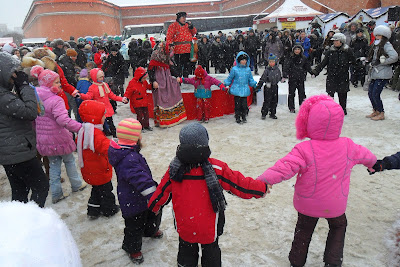
Historically, March 8 has been internationally associated with women's rights and a particular mass protest in New York on March 8, 1957. Women from sewing and shoe factories took to the streets, demonstrating for rights equal to men---> men had recently won a 10-hour workday. At that time, women worked 16-hour days! The protest was well publicized around the world, leading to yearly demonstrations on this date in the U.S. and Europe. It wasn't until 1910 that leading German, female socialist, Klara Zetkin, was struck with the fabulous idea of introducing a unique day to commemorate the struggle for women's rights, which eventually produced the spring holiday on March 8: International Women's Day! The holiday was first celebrated in St. Petersburg in 1913, but it was not an official holiday in Russia until 1965.
For Russia, this day is not so much about advocacy as much as it is about giving women gifts, flowers, and compliments to no end :D Flower shops prepare gigantic ready-made bouquets, stores stock up on chocolates, and all kinds of gifts, including real "medals of honor" for mothers, sisters, and friends, appear in every store. And don't forget about the champagne...
Here are some of my favorite images I found online:



(bwahhahahahahahaha!!!!)
Ahem.
In St. Petersburg this year, a very special event took place! But first, some history...

In 1903, a well-to-do family, the Eliseevs, opened a grand shop on the corner of Nevsky Prospect and Malay Sadovaya.

At that time, one could buy "colonial" goods: fresh truffles, oysters, unusual cheeses and fruit, wine, bakery products, and coffee. In the early days of the Soviet government, the store was nationalized. First, the lights, ornately designed lamps, were removed. Then, a hand-made carpet disappeared. In two days, all the products sold out as they were not being replenished. Soon, the store was renamed "Central Grocery #1." The store still sold specialty items like tangerines, bananas, eggs, sausage, and pineapples, but only the Leningrad Party elite shopped there. Starting from the 90's, the building just passed from one owner to another, starting afresh again and again. At one point, it was a cosmetics shop.
In 2010, businessman Eugene Prigogine purchased a 10-year lease on the building for 21 million rubles (a little over $710,000). He decided to restore the building to its original condition, which took two years and 130 million rubles (about $4.4 million).
The only difference from pre-revolutionary design is the giant palm tree/pineapple in the center of the store, surrounded by tables and open shelves of specialty chocolates, salts, liquor, and oils.

The store consists of four counters lining the walls, each selling its own specialty item: cheese, pastry, meat, and confectionary products. Suppliers come from as far as Italy, Spain, France, and Austria, but the pastries and pasta are from the ground floor. The mineral water and vodka is local as well, produced in specially-designed bottles for the store.



All sellers are specifically trained for their specialty items and are able to discuss at length the origin of everything available.
On the second floor (once offices) and in the basement (once a wine cellar), two restaurants are now open. French chef Julien Lasheno, winner of Michelin stars, supplies the menu with dishes of Russian, European, and Asian cuisine.
Anna Prozorov, the CEO of the Eliseev Brothers business is pleased with the store, believing that it has not radically changed at all since its original opening over a hundred years ago.

Above the back wall, a balcony protrudes with animatronic men waving:

These are the Eliseev Brothers, waving to all the new guests, welcoming them to explore their old store.
So.
When this opened, there was a line that rounded the corner. I was not there, but a couple days later, lines were still formed at the entrance. I waited, watching the guard at the door allow only a few people in at a time. It was the most enchanting building I have ever been inside, other than a museum.

Men on stilts have spent the last week roaming the sidewalks around the building, providing special balloons and simply drawing attention to the new store.



One day, I caught a band performing delightful band music outside the storefront.



It seems perfect for a luxurious store such as this to reopen on Women's Day. I imagine most of the people in that long line were women being treated or those buying women gifts. And I have to, have to wonder if there was someone in that line falling into nostalgia as those doors reopened.






































